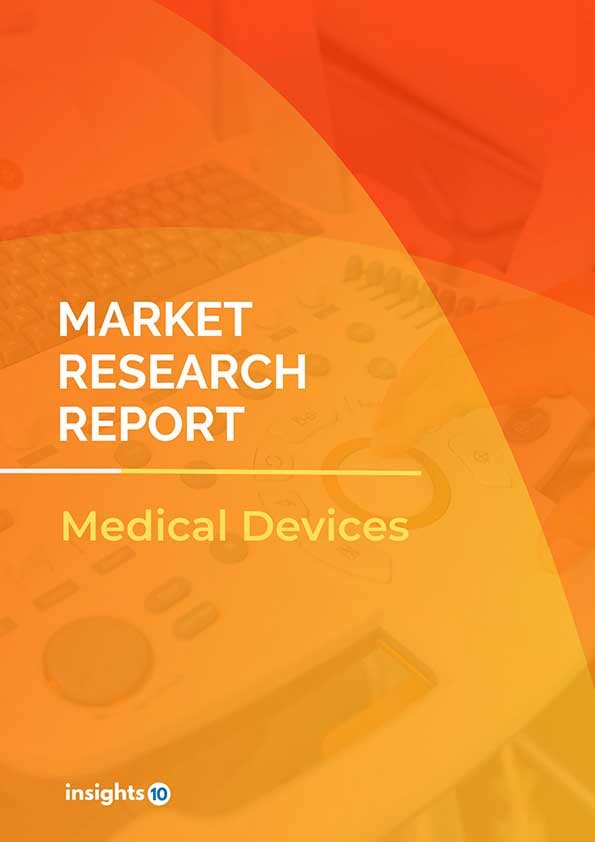Italy 3D Printing Medical Devices Market Analysis
Italy's 3D printing medical devices market size was valued at $71 Mn in 2022 and is estimated to expand at a compound annual growth rate (CAGR) of 15.8% from 2022 to 2030 and will reach $230 Mn in 2030. The market is segmented by component, application, technology, and end user. The Italy 3D Printing Medical Devices market will grow 3D printing technology has made a significant impact in the medical industry by enabling the production of personalized and complex medical devices. The key market players are Some of the key players in the market include 3D-Side, EGO3D, Mecuris Italia, MT Ortho, REJOINT, Storm Line, WASP MED, and others.
Buy Now

Italy 3D Printing Medical Devices Market Executive Summary
Italy's 3D printing medical devices market size was valued at $71 Mn in 2022 and is estimated to expand at a compound annual growth rate (CAGR) of 15.8% from 2022 to 2030 and will reach $230 Mn in 2030. Italy's healthcare expenditure was approximately 8.9% of GDP in 2019, according to data from the Organization for Economic Cooperation and Development (OECD). This is lower than the healthcare expenditure of other developed countries with universal healthcare systems.
3D printing technology has shown great potential in the field of medical devices, offering a range of benefits such as improved customization, precision, and cost-effectiveness. 3D printing technology has revolutionized the production of prosthetic limbs, allowing for the creation of customized prostheses that fit the patient's unique anatomy. 3D-printed prosthetics can also be produced more quickly and at a lower cost than traditional prosthetics. 3D printing technology can be used to produce customized implants that fit a patient's unique anatomy, reducing the risk of complications and improving patient outcomes.
In recent years, Italy has shown a growing interest in 3D printing medical devices as a way to improve patient outcomes and reduce healthcare costs. One example of this is the use of 3D-printed prosthetic devices, which can be customized to fit the specific needs of individual patients and reduce the need for costly surgical procedures.
Several Italian hospitals and research institutions have also been involved in research and development initiatives related to 3D printing medical devices, such as the production of customized implants and surgical instruments. The Italian market for 3D-printed medical devices is a quickly expanding and fiercely competitive sector that is expected to expand much more over the next several years. This market is anticipated to increase in the future due to the emphasis on innovative products, cost-effectiveness, and personalized medical devices.

Market Dynamics
Market Growth Drivers
Italy is renowned for its engineering prowess and cutting-edge technologies. The ability to produce individualized and sophisticated medical devices thanks to 3D printing technology has had a huge impact on the medical sector. This has fuelled the Italian market for 3D-printed medical devices. Moreover, medical equipment may be made specifically for each patient's needs thanks to 3D printing. The need for 3D-printed medical gadgets has grown in Italy as a result.
Additionally, With the increasing incidence of chronic diseases, the demand for medical devices that can improve the quality of life for patients has increased. 3D printing allows for the production of complex medical devices that can help in the treatment of chronic diseases, thereby driving market growth.
Market Restraints
- Lack of Skilled Workforce: The production of 3D-printed medical devices requires specialized skills and expertise. The lack of a skilled workforce can be a major challenge for companies looking to enter the market and scale their operations
- High Cost: The cost of 3D printing medical devices is relatively high compared to traditional manufacturing methods. This can be a major restraint in the adoption of 3D printing technology for medical devices
- Regulatory Challenges: The regulatory requirements for 3D-printed medical devices are strict in Italy, which can be a significant barrier to entry for new players in the market. This can also lead to delays in the approval process for new 3D-printed medical devices
Competitive Landscape
Key Players
- 3D-Side: This company specializes in the design and production of patient-specific implants for cranio-maxillofacial surgery using 3D printing technology
- EGO3D: EGO3D is a 3D printing company that produces customized prosthetic and orthotic devices for patients with disabilities or injuries
- Mecuris Italia: Mecuris Italia develops and produces personalized prostheses using 3D printing technology, with a focus on improving patient outcomes and quality of life
- MT Ortho: MT Ortho is a medical device company that produces orthopedic implants and surgical instruments using 3D printing technology
- REJOINT: REJOINT is a medical device company that produces custom-made knee replacements using 3D printing technology. Their implants are designed to improve patient outcomes and reduce recovery times
- Storm Line: Storm Line produces medical-grade 3D printing filaments and resin for use in a range of medical applications, including implants and surgical tools
- WASP MED: WASP MED is a medical division of WASP, an Italian 3D printing company. They produce custom-made prostheses and orthoses using 3D printing technology
Healthcare Policies and Regulatory Landscape
In Italy, medical devices, including those made using 3D printing technology, are regulated by the Italian Ministry of Health. The regulations are in line with European Union regulations, specifically the Medical Devices Regulation (MDR) and the In Vitro Diagnostic Medical Devices Regulation (IVDR).
To sell a 3D-printed medical device in Italy, manufacturers must obtain a Conformity Assessment Certificate from a Notified Body. The certificate confirms that the device meets the essential requirements outlined in the MDR and IVDR.
Manufacturers must also comply with the specific regulations for medical devices made using 3D printing technology. These regulations include requirements for the design, materials, production process, and validation of the devices. For example, the design of a 3D-printed medical device must be validated using computer-aided engineering (CAE) simulations, and the device must be produced using validated software and equipment.
Additionally, 3D-printed medical devices must undergo an appropriate testing and clinical evaluation to ensure they are safe and effective for their intended use. Manufacturers must also comply with post-market surveillance requirements, including reporting adverse events and conducting post-market clinical follow-ups.
1. Executive Summary
1.1 Device Overview
1.2 Global Scenario
1.3 Country Overview
1.4 Healthcare Scenario in Country
1.5 Regulatory Landscape for Medical Device
1.6 Health Insurance Coverage in Country
1.7 Type of Medical Device
1.8 Recent Developments in the Country
2. Market Size and Forecasting
2.1 Market Size (With Excel and Methodology)
2.2 Market Segmentation (Check all Segments in Segmentation Section)
3. Market Dynamics
3.1 Market Drivers
3.2 Market Restraints
4. Competitive Landscape
4.1 Major Market Share
4.2 Key Company Profile (Check all Companies in the Summary Section)
4.2.1 Company
4.2.1.1 Overview
4.2.1.2 Product Applications and Services
4.2.1.3 Recent Developments
4.2.1.4 Partnerships Ecosystem
4.2.1.5 Financials (Based on Availability)
5. Reimbursement Scenario
5.1 Reimbursement Regulation
5.2 Reimbursement Process for Diagnosis
5.3 Reimbursement Process for Treatment
6. Methodology and Scope
Italy 3D Printing Medical Devices Market Segmentation
By Component
The Italy market is divided into three categories based on the component: equipment, materials, and software & services. End customers frequently employ software and services for designing and processing control of 3D-printed medical devices, particularly for bespoke items. The cost-effectiveness, utility, uniformity, and precision given by services for medical device 3D printing, together with a rise in demand for personalized 3D printed medical equipment among hospitals and surgical centers, are driving the market demand for software & surgical guides.
- Equipment
- 3D Printers
- 3D Bioprinters
- Materials
- Plastics
- Thermoplastics
- Photopolymers
- Metals and Metal Alloys
- Biomaterials
- Ceramics
- Paper
- Wax
- Other Materials
- Services & Software
By Application
The Italy market is divided into surgical guides, surgical tools, tissue-engineered goods, hearing aids, wearable medical devices/implantable medical devices, standard prostheses and implants, custom prosthetics and implants, and other medical devices based on the application. Due to the widespread adoption of 3D printing technology in the production of prosthetics and implants, the increased availability of high-quality biomaterials and ceramics for 3D printing, and ongoing industry investment in the development of novel 3D printers, the custom prosthetics and implants segment is expected to hold a larger share of the market in 2022.
- Surgical Guides
- Dental Guides
- Craniomaxillofacial Guides
- Orthopedic Guides
- Spinal Guides
- Surgical Instruments
- Surgical Fasteners
- Scalpels
- Retractors
- Standard Prosthetics & Implants
- Orthopedic Implants
- Dental Prosthetics & Implants
- Craniomaxillofacial Implants
- Bone & Cartilage Scaffolds
- Ligament & Tendon Scaffolds
- Custom Prosthetics & Implants
- Tissue-engineered Products
- Hearing Aids
- Wearable Medical Devices
- Other Applications
By Technology
According to technology, the global market has been divided into three categories: three-dimensional printing (3DP) or adhesion bonding; electron beam melting (EBM); laser beam melting (LBM); photopolymerization; droplet deposition or extrusion-based technologies; and other technologies. The laser beam melting (LBM) segment is anticipated to hold the greatest market share in 2022, in large part due to the growing use of this technology in the dental sector and for the production of implants for minimally invasive surgery.
- Laser Beam Melting
- Direct Metal Laser Sintering
- Selective Laser Sintering
- Selective Laser Melting
- LaserCUSING
- Photopolymerization
- Digital Light Processing
- Stereolithography
- Two-photon Polymerization
- PolyJet 3D Printing
- Fused Deposition Modeling
- Multiphase Jet Solidification
- Low-temperature Deposition Manufacturing
- Microextrusion Bioprinting
- Droplet Deposition/Extrusion-based Technologies
- Electron Beam Melting
- Three-dimensional Printing/Adhesion Bonding/Binder Jetting
- Other Technologies
By End User
The Italy market has been divided into hospitals and surgical facilities, dental and orthopedic clinics, academic institutions and research labs, pharma-biotech and medical device firms, and clinical research organizations based on end users. In 2022, hospitals and surgical centers are anticipated to hold the greatest market share. The high proportion of this market may be due to the ongoing expansion of internal 3D printing capabilities, the expansion of existing 3D printing laboratories, the rising affordability of 3D printing services, and the quick uptake of cutting-edge technology by hospitals in developed markets.
- Hospitals & Surgical Centers
- Dental & Orthopedic Clinics
- Academic Institutions & Research Laboratories
- Pharma-Biotech & Medical Device Companies
- Clinical Research Organizations
Insights10 will provide you with the reports within 10 key parameters which are:
- Market Overview
- Market Growth Drivers & Restraints
- Epidemiology of Disease Type
- Market Segmentation
- Market Share
- Competitive Landscape
- Key Company Profiles
- Healthcare Policies & Regulatory Framework
- Reimbursement Scenario
- Factors Driving Future Growth
Based on our many years of experience, we believe that these are the parameters that are critical to decision-making for business stakeholders. Our focused approach to developing reports focused on 10 key parameters, enabled us to arrive at the name “Insights10”.

Stage I: Market Data Collection
Primary Interviews: We have developed a network of experts, freelancers, and researchers across countries through which we engage with local experts to gather key data points and assumptions about each market. We also engage regularly with some of the best market research agencies such as Atheneum, GuidePoint, GLG, etc. to conduct surveys and interviews, and build intelligence. We have language translators as a part of our team, who between them can cover 30+ languages allowing us to extract better local insights.
Secondary Data Collection: We have developed strong expertise and experience in secondary data collection methods for developing unique data sets and research material. We gather data from multiple reliable sources to maintain a high level of accuracy and consistency. The market data is analyzed and forecasted using appropriate statistical and coherent models. The report offers an overall analysis of the market size, growth, and market share as well as a segment-level analysis of the specific market. Our report includes precise, to-the-point information related to the overall market, competition, growth drivers, challenges, regulatory updates, and competition.
Data Sources: We have access to multiple highly reliable free and subscription data sources. We have many years of experience to understand which sources are more dependable for what and which to prefer for the reliable and latest information. The key sources of information include the following, but are not limited to:

Stage II: Market Data Analysis and Statistical Model
Market Trends: We generally look at macro parameters and micro indicators. The macro parameters include changes in government policies, demand and supply of the market, government intervention programs, and major market share. The micro indicators are GDP growth, market size, market volume, etc. We also understand nuances specific to each country like the US, Canada, India, Germany, etc., and have worked across 60+ countries and hence not only understand global trends but how these differ by country, how payment models, market structure, cultural parameters, etc. differ in each country.
Market Sizing and Analysis: Our expert data analytics team has created various market forecast models by employing the top-down approach i.e. starting with the large overall market and segmenting different areas and the bottom-up approach i.e. starting with population and epidemiology and rolling up based on spend, etc., estimating the size of the market, and distributing among the geographic and/or product segments.
The top-down approach is mainly used for new product forecasting and the bottom-up approach is used for demand estimation of any product for different countries summed up to form the total market. We are able to round off insights and build stronger forecasts because we always do both these methods and triangulate the final numbers.
The study on the market covers the analysis of the leading geographies such as Asia-Pacific, Africa, Europe, Middle East, North America, and Latin America for the period of 2022 to 2030. The qualitative analysis covers the industry landscape and trends, market opportunities, competitive landscape, and policy and regulatory scenario, and the quantitative analysis covers different market estimates and forecasts.
Data Triangulation & Validation:
Data triangulation of various sources and results of the research are carried out by benchmarking with reliable sources such as industry statistics, statistical databases, and company-level averages, etc.
We make sure to finalize the numbers in alignment with the market research. Firstly, our internal experts ensure thorough validation and checking to ensure accurate and precise analysis and then validation is also done using a multiple-data analysis model. Two-level validation is done and entails the finalization of the report scope and the way of representation pattern.
(1).png)
Stage III: Interpretation and Presentation
Analysis & Interpretation: The information gathered is then analyzed and synthesized. The second series of interviews are done if necessary to check and validate. The future opportunities are analyzed by understanding product commercialization and many other factors. It also comprises the analysis of data discrepancies observed across various data sources. Information procured from secondary and primary results is then, interpreted by considering the following parameters: (a partial list)
- Establishing market drivers and trends
- Analyzing the regulatory landscape to understand future growth
- Market Segment based analysis to obtain revenue/volume
- Analyzing current needs and determining penetration to estimate the market
Insights: Our reports deliver actionable insights backed with supporting facts and figures to assist you in achieving exemplary growth. Our in-depth analyses are interspersed with relevant insights and statistics to offer an executive-level view of a given market. The description helps in correlating many minor factors affecting the market and their impact on the different segments within the market.
Data curated from the analysis and interpretation are drawn to portray all in one consolidated report.
Presentation & Reporting: The market research report is presented in different forms such as charts by using a scientific approach for easy understanding. Historic, current, and future analysis is provided for each market in terms of both value and volume. The size of the market is interpreted in the US Dollar value and the respective unit, based on the product, for volume consumption.
The foreign exchange rates are calculated on the respective dates and for the respective regions covered in the study.
To request a free sample copy of this report, please complete the form below.
We value your inquiry and offer free customization with every report to fulfil your exact research needs.
This report addresses
- Intelligent insights to take informed business decisions
- Qualitative, acute and result oriented market analysis
- Market size and forecasts from 2022 to 2030
- Opportunities for expansion and in-depth market analysis
- Segmentation and regional revenue forecasts
- Analysis of the market share and competitive landscape
- Strategic Recommendations to chart future course of action
- Comprehensive Market Research Report in PDF and PPT formats
Need more?
- Ask our analyst how this study was put together to learn more
- Discuss additional requirements as part of the free customisation
- Add more countries or regions to the scope
- Get answers to specific business questions
- Develop the business case to launch the product
- Find out how this report may influence your business revenue




